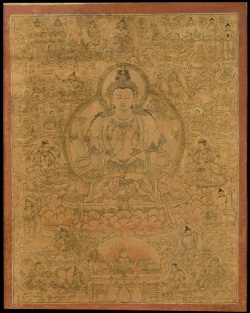Shadakasari Lokesvara
Sadaksari-Lokesvara Lord of the 6 syllables - Avalokitesvara as Sadaksari Lokesvara
Sadaksari-Lokesvara is also known as Kharchheri, he is the ‘Lord of the Six Syllables’.
These six syllables belong to the mantra ‘Om Mani Padme Hum’, the expression of the deepest essence of Avalokitesvara.
Sadaksari has four arms, in one hand he holds the akshamala, which serves to count the number of times that the mantra is spoken,
in the other hand he holds the lotus of absolute purity.
He holds the magic jewel Cintamani in front of his chest.
His spiritual father, Amitabha
Sadaksari Lokesvara, four-armed bodhisattva seated in dhyanasana on a double lotus base, his principal hands held in anjali mudra, the other pair in harina mudra, the blue hair tied up in a top knot surmounted by the head of Amitabha, adorned with jewelry and wearing a goat skin over his dhoti, sealed.
Avalokiteshvara, Chaturbhuja Sadaksari (Tibetan: chen re zi, chag shi pa yi ge drug pa.
English: the All-seeing Lord with Four Hands, Having Six-syllables): the great bodhisattva of compassion, with four hands representing love, compassion, joy and equanimity.
Held in the main pair of hands at the heart is a blue wish-fulfilling jewel.
In the upraised right is a crystal mala of beads and in the left a pink lotus blossom.
"As the nature of all buddhas, Avalokiteshvara, in colour like stainless conch and crystal, very resplendent, smiling, peaceful and radiant.
With four hands the first are folded at the heart, the lower hold a crystal mala and jewelled lotus, two beautiful feet seated in vajra posture, adorned with many attractive silks and jewels, beautified with dark blue hair in tufts [some] loose.
On the crown of the head, the wisdom of all buddhas, is the Lord, source of all refuge gathered as one, in essence the Guru in the aspect of Amitabha, in the manner of the Lord of the Family, seated happily."
(Ngorchen Konchog Lhundrup 1497-1557).
Avalokiteshvara is the patron bodhisattva of Tibet and is practiced by all traditions.
There are numerous Sarma lineages and different forms of practice which span all four tantric classifications as well as uncounted Kama and Terma (treasure traditions from the Nyingmapa School.
